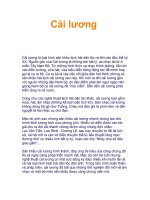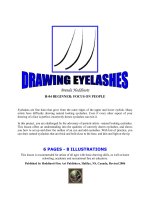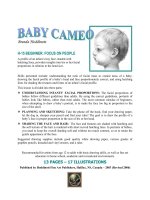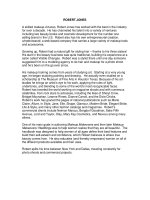Tài liệu Drawing Eyelashes doc
Bạn đang xem bản rút gọn của tài liệu. Xem và tải ngay bản đầy đủ của tài liệu tại đây (570.23 KB, 6 trang )
Brenda Hoddinott
H-04 BEGINNER: FOCUS ON PEOPLE
Eyelashes are fine hairs that grow from the outer edges of the upper and lower eyelids. Many
artists have difficulty drawing natural looking eyelashes. Even if every other aspect of your
drawing of a face is perfect, incorrectly drawn eyelashes can ruin it.
In this project, you are challenged by the adversary of portrait artists –natural looking eyelashes.
This lesson offers an understanding into the qualities of correctly drawn eyelashes, and shows
you how to set up and draw the outline of an eye and add eyelashes. With lots of practice, you
can draw natural eyelashes that are thick and bold close to the base, and thin and light at the tip
6 PAGES - 8 ILLUSTRATIONS
This lesson is recommended for artists of all ages with basic drawing skills, as well as home
schooling, academic and recreational fine art educators.
Published by Hoddinott Fine Art Publishers, Halifax, NS, Canada, Revised 2006
Copyright to all articles, images, text, projects, lessons and exercises within this drawing class belong to Brenda Hoddinott and may
not be reproduced or used for any commercial purposes whatsoever without the written permission of Brenda Hoddinott.
Web sites and
2
DRAWING EYELASHES
Eyelashes are fine hairs that grow from the outer edges of the upper and lower eyelids. The
upper eyelid is the larger, movable fold of skin above the eyeball that opens and closes to protect
the upper and center sections of the eye. The lower eyelid is a smaller, less movable, fold of skin
protecting the lower eyeball. Many artists have difficulty drawing natural looking eyelashes.
Even if every other aspect of your drawing of a face is perfect, incorrectly drawn eyelashes can
ruin it.
Eyelashes, though tiny, are the most challenging parts of human anatomy to draw realistically! In
Illustration 04-01, you see unnatural looking individual eyelashes that are the same value and
thickness from root to tip. Eyelashes drawn with this type of line can’t possibly look correct.
Illustration 04-02 shows the correct way to draw individual eyelashes. Each eyelash is thick at
the bottom, and gradually becomes lighter and thinner closer to the tip.
ILLUSTRATION 04-01 ILLUSTRATION 04-02
In this illustration of three
eyes, have a peek at some
common mistakes
made when drawing
eyelashes, such as
making them too
thick, too straight
or too long.
ILLUSTRATION 04-03
Copyright to all articles, images, text, projects, lessons and exercises within this drawing class belong to Brenda Hoddinott and may
not be reproduced or used for any commercial purposes whatsoever without the written permission of Brenda Hoddinott.
Web sites and
3
Don’t expect to master drawing eyelashes right away. Take lots of time to practice before you try
adding them to your drawings of people. With lots of practice, you can draw natural eyelashes
that are thick and bold close to the base, and thin and light at the tip. Examine the eyelashes in
the next two illustrations.
ILLUSTRATION 04-04
ILLUSTRATION 04-05
The following criteria provide insights into various aspects of drawing realistic eyelashes. Refer
to the previous two illustrations, and the next. Take note that correctly drawn eyelashes:
Copyright to all articles, images, text, projects, lessons and exercises within this drawing class belong to Brenda Hoddinott and may
not be reproduced or used for any commercial purposes whatsoever without the written permission of Brenda Hoddinott.
Web sites and
4
Grow in many different directions, mostly outward from the eyelids.
Are rendered with thin lines of different lengths.
Are curved and unevenly spaced.
Appear thicker closer to the eyelids.
Grow from the outer edges of the upper and lower eyelids and not the white of the eye.
Are drawn in groups rather than single lines.
Gradually become longer and thicker toward the outer corners of the eye.
ILLUSTRATION 04-06
Correctly drawn eyelashes look natural and lifelike. A simple little drawing technique provides a
realistic looking eyelash every time - in simple terms, never draw eyelashes from the tip down
toward the eyelid. Always draw them in the direction in which they grow, from the eyelid (or
root) outward. Grab some paper and a 2B pencil. Refer to the next close up drawing, and try your
hand at drawing realistic looking individual lashes.
1. Begin at the base of the eyelash and press firmly with your pencil.
Remember; always draw eyelashes in the direction they grow, from the eyelid outward.
ILLUSTRATION 04-07
2. Slowly release the pressure you apply as
your curved line extends toward the tip.
Realistic eyelashes look like
inverted commas – thick at the
bottom and thin at the top.
3. Gently lift your pencil
from the paper when the
tip of the line is very thin
and light in value.
Copyright to all articles, images, text, projects, lessons and exercises within this drawing class belong to Brenda Hoddinott and may
not be reproduced or used for any commercial purposes whatsoever without the written permission of Brenda Hoddinott.
Web sites and
5
Warm up your drawing hand and draw an eyeful of eyelashes.
ILLUSTRATION 04-08
1) Lightly sketch the almond shape
of an eye, with a double line at
the top and bottom, to
represent the thickness
of the flesh of
the eyelids.
2) Use 2H and HB pencils, to draw an average quantity of eyelashes, on the outer edges of
the upper and lower eyelids.
ILLUSTRATION 04-09









